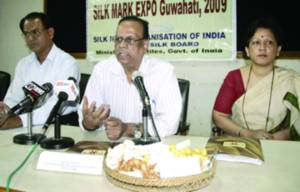Archives
China’s Cheap Imports Harm Indian Silk Industry

The Silk Mark and Muga Mark are envisioned as the quality assurance systems for mulberry silk and muga silk products to protect the interest of the consumers as well as the grass root level producers. The Chief Executive Officer of the Silk Mark Organisation of the Central Silk Board, K S Menon, who is trying hard to promote the Silk Mark across the country was in the Guwahati recently for Silk Mark Expo held on the occasion of the fourth anniversary of the Silk Mark at the NEDFi Haat and in a talk with Mr. Utpal Kanta of Eastern Panorama, he gives his outlook on the current scenario of the Indian Silk Industry. Major excerpts of the interview are as follows:
E.P - What is the current status of the Indian silk industry?
K.S.M - India is the second largest producer and exporter of silk in the world after China but has the dubious distinction of also being the largest importer of raw silk or silk yarn in the world. Against demand of between 26,000 MT and 27000 MT India produces around 19,000 MT of all varieties of silk in a year, which means a demand-supply mismatch. In this respect, it is second to China, which produces 1,30,000 MT of silk annually. The country earned around Rs 3,200 crore from its silk sector in 2007-08 and the market for its silk products is located in European Union countries, Japan, the Middle East and USA. The country imports between 7,000 MT and 8,000 MTs of silk products annually from abroad to meet around 30 per cent of its requirement and China is the main source of its imports with around 4,000 MT of mulberry products coming from that country.
E.P - What is the current scenario of sericulture in Assam?
K.S.M - Assam has a very rich tradition of Sericulture and has a very strong weaving culture. Assam enjoys a very special status in sericulture as it produces all the three types of silk. Assam is rich in tradition as well as in production, conversion and consumption in terms of silk. Assam contributes almost 90% of Muga silk and 65% of Eri silk production in the country. Moreover, food plants for Eri are abundantly available in the state, unlike Muga which needs continuous nourishment to be provided by the growers. As a result, Eri contributes 87% of the entire silk production in the state, while Muga accounts for 12% and the contribution of mulberry is only one per cent. The number of families associated with sericulture in the state increased from 1.85 lakhs in 2006 to 2.39 lakhs in September, 2008. Women are actively involved in sericulture, accounting for two-thirds of those employed in the industry. The workforce in the industry has also grown robustly, with 43% more people now employed in Eri cultivation and processing.
E.P - What is the current trend at the export and import corner of silk sector?
K.S.M - India’s silk import declined by 3.33 per cent in value terms to 203 million dollars during the first half of the 2008-09 fiscal year. Silk import from other countries such as Brazil and Uzbekistan, which were normally less than 30 tonnes, saw a further dip, while purchases from China remained highest during the review period. India has been sourcing both raw silk, silk yarn and fabric from the global market from the first Five-Year Plan period in 1954. The silk yarn and fabrics import were slightly down in comparison with raw silk. In value terms, fabric imports stood at 98.60 million dollars in April-September 2008-09 against 111.63 million dollars in a year-ago period. India bought 4,346 tonnes of raw silk at 105.23 million dollars during the first six months of the current fiscal compared with 4,267 tonnes at 98.88 million dollars in the same period of the previous year. India shopped two tonnes of raw silk from Brazil, eight tonnes from Hong Kong and three tonnes from other countries. On the contrary, raw silk imports from China stood at 4,333 tonnes during the review period. Interestingly, silk import from China has been rising in the last few years, with over 38 per cent jump seen in 2007-08 fiscal at 12,535 tonnes from the previous year.
Silk exports will continue to fall in 2009 to Rs. 2,000 crore after touching a record Rs3,500 crore in 2007. Exports are expected to maintain their decline after falling to Rs2,500 crore in 2008 on the back of a global economic slowdown.The year 2009 will spell the death knell for the Indian silk industry. Big factories have started reducing number of shifts, ancillary factories are shutting down and big export orders from the US and the UK, our two biggest clients, are getting cancelled. We believe big silk mills will start closing down by February-March. Factory closures would mean job losses in a sector that currently employs about 1.4 million people.
We are preparing to market silk more aggressively in the domestic market as well as find new categories for silk use. The impact of the slowdown will worsen after February, till the end of which shipping of previous export orders will continue.
E.P - Would China’s cheap imports harm the Indian silk industry?
K.S.M - It is correct that imports from China are causing severe problems for the sericulture farmers here. The seriousness of the situation could be gauged from the fact that the imported Chinese raw silk is now available at $13 per kg as against the $20 in 2000. I feel that this is a fit case to be treated and taken up under the anti-dumping provisions.
CSB had moved the ministry of commerce to take up the necessary steps in this regard and we firmly believe that anything below $18 per kg is going to be less than cost of production for the Chinese makers.

